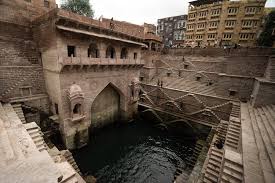(单词翻译:单击)
India has thousands of surviving stepwells, but the great majority are similarly run-down. Many others have vanished, often filled in and built upon. This neglectful attitude is extraordinary, for they are one of India’s unsung wonders. At last, through restoration efforts by the Aga Khan Trust for Culture (AKTC), among others, they are starting to get the recognition they deserve.
印度有数千口现存的梯级井,但绝大多数梯级井也同样在衰竭。许多已经消失,经常需要填补和重修。这种忽视的态度是不同寻常的,因为梯级井是印度无名的奇迹之一。最后,通过阿加汗文化信托基金等机构的修复努力,梯级井开始得到应有的承认。

The earliest of the wells date back almost 2,000 years. They were first and foremost a response to a climate in which a year’s rains fall chiefly in the four brief months of the summer monsoon, when they fall at all. The point of the staircases and side ledges is to provide permanent access to ever-fluctuating water levels—and cool shelter in the hottest months. In the north-western regions that are India’s most arid, such as Rajasthan and Gujarat, the baolis underwrote life, as sources of both irrigation and drinking water. They were often located on ancient trade routes. In Delhi, every community once had its own tank.
最早的梯级井可以追溯到2000年前。梯级井首先是对一种气候的反应,在这种气候中,一年的降雨主要集中在夏季季风的四个月里,而这四个月正是雨季来临的时候。楼梯和侧壁架的重点是为不断波动的水位提供永久性的通道,并在最热的月份提供凉爽的庇护所。在印度最干旱的西北地区,如拉贾斯坦邦和古吉拉特邦,baoli作为灌溉和饮用水的来源,支撑了人们的生活。它们通常坐落在古老的贸易路线上。在德里,每个社区曾经都有自己的水槽。
Many stepwells were used for ablution; the tanks associated with mosques, Hindu temples and other shrines offered the most purificatory form. Summoning water from the depths was also a symbol of temporal power. Around Hyderabad in south-central India, many of the baolis were built by kings and zamindars. A surprising number were built at the behest of women, including princesses, courtesans and merchants’ wives, who wished to attain immortality through the gift of water. Indeed, stepwells have always been considered women’s spaces—places to gather without inhibitions, away from men’s domineering eyes (in India, after all, it is traditionally a woman’s job to fetch and carry water). Rani-ki- Vav, or the queen’s stepwell, in Patan in Gujarat, graces the new 100-rupee note.
许多阶梯井用于洗浴;清真寺、印度寺庙和其他神殿的水槽提供了最洁净的方式。从深处召唤水也是世俗力量的象征。在印度中南部的海德拉巴周围,许多宝丽寺是由国王和赞美达建造的。在女性的要求下,包括公主、交际花和商人的妻子,她们希望通过水的礼物获得永生,因此建造了数量惊人的雕像。事实上,阶梯井一直被认为是女性的空间——一个不受约束、远离男性霸道目光的地方(毕竟,在印度,传统上取水和挑水是女性的工作)。古吉拉特邦帕坦的“女王阶梯井”为新版面值100的卢比增色。
译文由可可原创,仅供学习交流使用,未经许可请勿转载。


